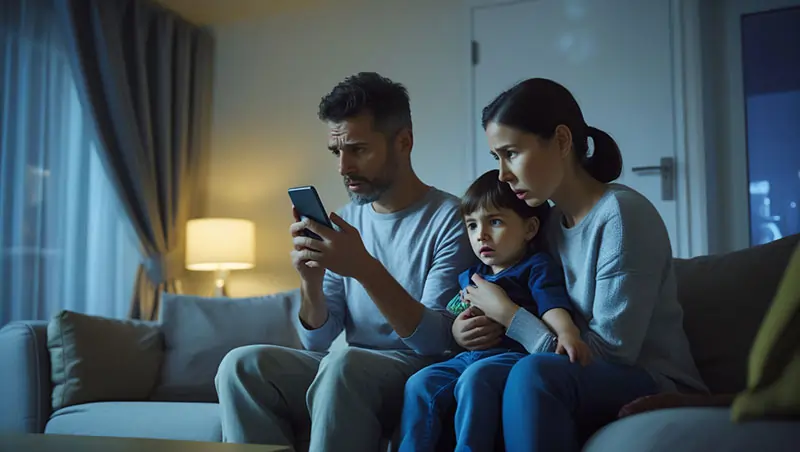Break-In Safety Steps Families Should Take Before Help Arrives
A break-in can unfold in seconds but leave families feeling unsettled for years. The fear of someone entering your home isn’t just about property; it’s about safety, control, and the instinct to protect your loved ones, especially children. In those high-stress moments before help arrives, confusion can turn dangerous if no one knows what to do.
Law enforcement agencies consistently stress a single principle: preparation saves lives. A clear, well-communicated plan can turn panic into decisive action. Practical, easy-to-follow steps—based on guidance from experienced officers and safety professionals—can make a real difference. When every household member, including kids, knows what to expect, staying calm and responding effectively becomes far more likely, even during one of the most high-pressure situations a family may encounter.
Lock Down and Stay Put in a Pre-Planned Secure Room
Having a designated safe room can be a lifesaver. This room should have a solid-core door that’s harder to break down. If you keep any defensive tools, ensure they are stored in a secure spot inside the room—well out of children’s reach but ready if absolutely necessary. A Fort Knox gun safe can be a reliable option for storing defensive tools while keeping them protected. Always keep a fully charged phone and a backup battery in this space so you can call for help without losing connection.
Silence matters as much as physical setup. Staying quiet helps avoid detection and promotes calm. Keep essentials—water, flashlight, first-aid supplies—organized and nearby. Fewer windows improve concealment. Make sure every family member knows the plan, the location, and what steps to follow if danger arises.
Stay Quiet and Avoid Drawing Attention to Your Location
Being completely silent can change the outcome of a break-in. If the intruder thinks no one’s home, the risk of direct contact can drop. Knowing your safe room well helps keep things quiet—avoiding bumping into furniture or making noise. Place padded stickers or felt pads under furniture legs to reduce accidental sound. Go barefoot or wear soft-soled shoes to reduce sound when moving.
Mute phones and other devices so alerts don’t give you away. Even a small noise, like a dropped key or message alert, can be risky. Lower the lights or close the curtains to stay hidden. Teaching even young children those small habits in a calm, age-appropriate way builds better safety overall.
Relay Only Key Details to Dispatch During the Call
When calling 911, ensure your communication is concise and precise. Say your full address clearly, including any apartment or unit number. Let them know how many people are with you, and whether you’re in a secure room or out in the open. Giving dispatch your phone number is also helpful in case the call gets disconnected.
If it feels safe, share what you can about the intruder—how they look or what they’re doing, including any visible clothing or direction of movement. Mention pets too, so officers know what to expect. Staying calm and focused during the call helps speed up the response and avoids confusion.
Do Not Attempt to Confront or Follow the Intruder
Trying to confront someone breaking in is dangerous. You don’t know what the person might be carrying or how they’ll respond if startled. Confrontation puts everyone in the house at greater risk, especially if children or elderly family members are present. Even if it’s tempting, don’t try to scare them off or follow them.
Stay hidden instead. If you move around, creaking floorboards or shadows that change shape might give away where you are. Get behind something strong, like a wall or a piece of furniture, and stay low. Breathe in and out slowly and deeply to stay calm and think clearly until help comes.
Turn Off Alarm Panels and Interior Lights If Accessible Without Exposure
If you can do so without being seen, turn off the alarm panels and interior lights. If an alarm goes off while someone is breaking in, turn it off only if you can do so without being seen or heard. Loud noise could make things worse by scaring the intruder. If you’re already in a safe room or hidden space, don’t take any chances to get to the panel. Safety comes first.
A dark inside makes it harder to find, but outside lights should stay on to help first responders find the house. You can use your phone to change the lights and alarms in your smart home from anywhere, but only when it’s safe and quiet to do so. Don’t do anything that could give away your location or make it harder to hide.
Knowing what to do during a break-in can help you feel less scared and confused. Stay in your safe room, be quiet, and keep your phone close by so you can only give important information. Don’t move around in a way that might give away where you are. Don’t try to confront or follow the intruder; it’s much safer to stay hidden. Only use lighting and alarm controls when it’s completely safe. Talk to your family about the plan ahead of time so that everyone is ready. You get more confident the more you do it. A plan that you fully understand isn’t just about safety; it also gives you something powerful when things get crazy: clarity. That calm can make a big difference when every second counts.



